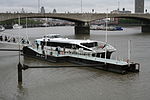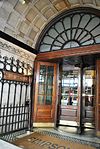Liberty of the Savoy

The Savoy was a manor and liberty sandwiched between the Liberty of Westminster, on two sides, the Inner and Middle Temple corner of City of London and a steep bank of the Tideway. It was in the county of Middlesex. It was all held by the Duchy of Lancaster, and was also known as the Liberty of the Duchy of Lancaster. The duchy (monarch) has kept some reversionary (underlying freehold) interests and the Savoy Chapel outright. The manor, enjoying the status of a liberty, comprised the precinct of the Savoy, the southern half and detached south-west of the parish of St Clement Danes and about three quarters of St Mary le Strand as it only, in a tiny part, extended north of the Strand whereas those parishes straddled this ancient road.
Excerpt from the Wikipedia article Liberty of the Savoy (License: CC BY-SA 3.0, Authors, Images).Liberty of the Savoy
Strand, London Covent Garden
Geographical coordinates (GPS) Address Nearby Places Show on map
Geographical coordinates (GPS)
| Latitude | Longitude |
|---|---|
| N 51.5097 ° | E -0.12 ° |
Address
Savoy Hotel
Strand
WC2R 0EU London, Covent Garden
England, United Kingdom
Open on Google Maps










